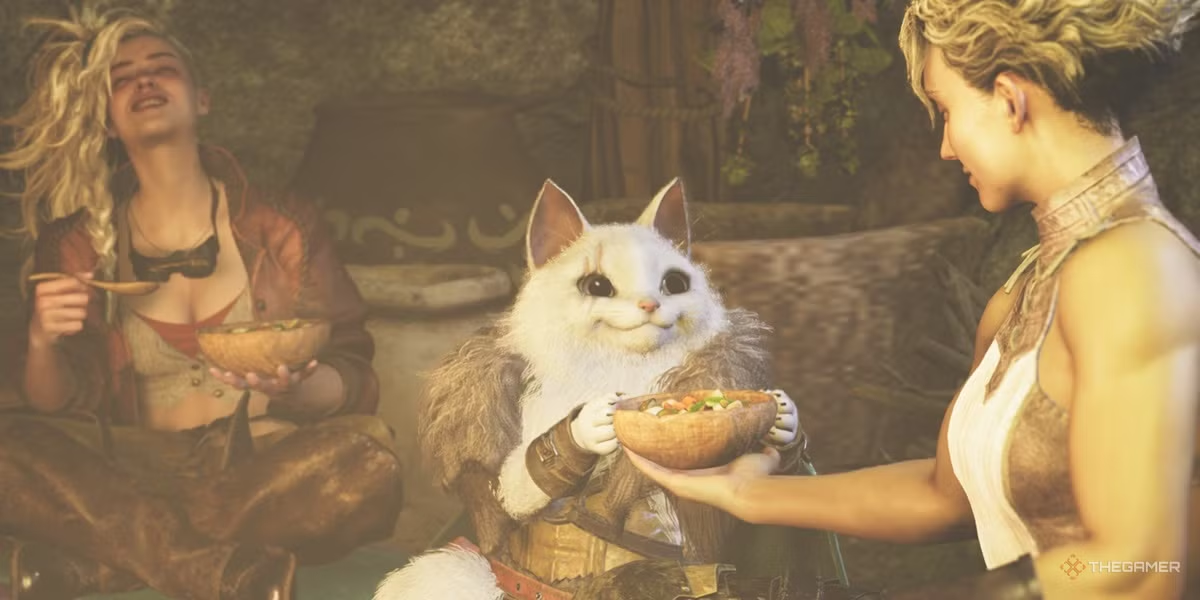It’s mainline Monster Hunter time, y’all!
After the unexpected smash hit that was Monster Hunter: World, Capcom’s back with a new mainline title. This time including a simultaneous launch on PC, which says a lot about how big this series is now. I’ve been playing Monster Hunter since MH3 so I was very eager to dive in on my PS5 at launch.
Fast forward to when I’m writing this and I’m roughly Hunter Rank 100 with some excellent gear and a passion for dootin’ the hunting horn. In other words: it’s time to talk Monster Hunter!
Let’s get a one thing out of the way first. Yes, Wilds does feel easier than pretty much all previous Monster Hunter games I’ve played. I breezed through low rank (which was expected) and hardly carted once in high rank (which was unexpected). The drop rates felt very high so I could almost always craft the weapon and armor I wanted, too. Finally, a lot of quality of life features make the hunts go by pretty quick.
With all that said, I think this is mostly a good thing! I’m an adult with a job, a needy cat, and other hobbies. A game not requiring an enormous time investment to make a little bit of progress is pretty damn nice. I also think that when we get Master Rank (AKA G-Rank, the almost mandatory expansion most Monster Hunter games get), it’ll be much more challenging. I think this is very much on purpose by Capcom, too. Monster Hunter is notoriously difficult to get into as a new player. With Wilds, I believe that was a big goal for them to change and so far the numbers seem to back this up. To ease these players in with moderate difficulty and then release challenging content later is a great recipe for success.
OK, difficulty aside, let’s talk about the game! It’s still Monster Hunter. You hunt big boss creatures and make cool gear out of their skin and bones. The gameplay loop of hunting a monster to upgrade your gear to then take on bigger monsters is still as uniquely captivating as it ever was. Capcom are fantastic stewards of this IP too, so if you’ve been playing for a while there’s plenty of callbacks and returning concepts for you to smile at. The amount of time some staff must’ve spent on designing and animating food alone… it boggles the mind! It’s at the point where one of the game’s first food scenes caused a spike in popularity for cheese naan in Japan.

It’s not all the same though. Monster Hunter: Wilds is changing up some things. There’s a bigger focus on a linear story for the first part of the game, acting as an engaging tutorial of sorts. For a returning player this dragged out a little bit, but I think it’s great for someone new to the franchise. Then there’s the new mount, the Seikret, that picks up where the Palamutes from Monster Hunter: Rise left off and make traversing the semi-open world much faster. The gameplay itself has also been updated and without getting too deep into it, every weapon (Monster Hunter’s equivalent to a “class”) has changes and additions compared to previous entries.
Personally I’m a rootin’ dootin’ Hunting Horn player and have been for as long as I’ve been playing Monster Hunter. After a bit of a low point in World and a weirdly powerful version in Rise, I feel the Hunting Horn has found a nice and balanced new identity in Monster Hunter: Wilds. It’s at the bottom of all speed run tier lists, making it a great weapon for a hipster like me. Of course, this is actually a fine trade-off for what is a partial support weapon.

If you don’t know, the Hunting Horn is a big ‘ol instrument that you swing around to bash the monsters with. As you swing it, you play notes (Triangle, Circle, or Triangle+Circle on a PlayStation controller). Certain sequences of notes make up a song and the hunter can perform these songs at will for both damage and buffs. The buffs also apply to your fellow hunters so everyone loves teaming up with a Hunting Horn player! To be honest I mostly play single player anyway, I just really enjoy bashing monsters with a musical instruments.
New in Wilds is the ability to create Echo Bubbles, an area of effect with positive buffs. Dootin’ your horn inside the area also adds additional damage to your attacks and performances. This adds a lot more strategy to the weapon. Where previously you could be tempted to run away from the monster, perform your songs for buffs, and then go back in—you’re now incentivized to create echo bubbles and perform your songs in the monster’s face for some serious damage.
If I had one complaint about my weapon of choice, it’s that there’s a bug (or oversight) that makes it nigh impossible to hit triangle and circle together during certain moves. Both during Echo Bubble and when using a Focus Strike to destroy a monster’s wound, you can input extra notes in what I can only describe as a miniature rhythm game. Here, for some reason, the double button input needs to be frame perfect so it’s extremely frustrating to get right… Hopefully this will be fixed in a patch!
That’s four paragraphs about Hunting Horn… so let’s talk about something else! How about the titular monsters? Capcom did a fantastic job with both the new and returning monsters. They all have gorgeous animations, interesting patterns, and are fun to fight. I wish there were a few more of them, but it’s not a big deal. The new apex predators, in particular, are all very cool designs and interesting fights. Though my personal favorite is Xu Wu, a weirdly agile and scary octopus monster. I let out a little yelp the first time that bastard showed me its underside, which I think is a good grade for a monster.

I won’t talk more about the monsters since I feel the absolute best part of Monster Hunter is meeting one for the first time. I do want to talk more about the world though! What Wilds does extraordinarily well is making all locations feel like working ecosystems. There’s weather, day and night cycles, interesting plants, and tons of critters and creatures—very different from the monsters we’re hunting.
My favorite thing in World was just walking around the levels, catching endemic life with my Capture Net and picking up various useful items. It felt so alive, and so does Wilds. There’s also plenty of things to discover if you take the time to walk around—from new pop-up camp locations to useful items to super rare little critters you can try to catch. I’m not ashamed to say I spent a decent amount of time fishing and, once I understood the controls, found that really enjoyable.
Monster Hunter: Wilds practically showers you in things to do and collect and it’s always to your benefit to do so. You can trade gathered trinkets for useful items, craft potions and traps, and much more. Maybe that’s why I’m still hoping for some tougher difficulty in a future expansion, because it was not often that I felt that I actually needed all these items that are supposed to help make the hunt easier. Even the endgame, designed to be a grind for the perfect gear, felt like it was over surprisingly quickly. Which on one hand was a disappointment, but on the other hand freed me from an unhealthy obsession and sleeping pattern.
There’s more to say about Monster Hunter: Wilds, and I’m sure I will return to it with the upcoming free DLC monsters, but I’ll leave it here for now. I had a really good time my first 50 hours in Monster Hunter: Wilds. Those 50 hours happened in the span of about a week, which says a lot about just how addictive and engaging this game is— and I’m not done here. There will be plenty more huntin’ and dootin’ ahead.
Things I liked:
- Hunting monsters is still fun after all these years
- Great environments brimming with life and character
- Exciting new monsters (and returning favorites)
- Quality of life improvements that really made a positive impact
- Plenty of fun side activities like fishing and collecting endemic life
- Seriously, the food animations 🧀
Things I didn’t like:
- Due to the lower difficulty level, some systems feels like unnecessary leftovers you don’t need to engage with
- The story’s a bit hit and miss in writing and pacing
- The end game is currently a bit shallow, though it’s likely to evolve through patches
- Hunting Horn frame perfect input timing 🤬

